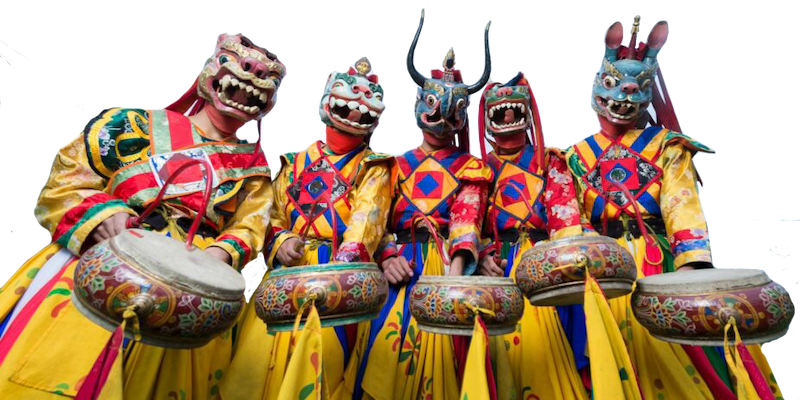Paro – Elevation 2,280m (7,480ft)
The home of the only airport in Bhutan, the Paro valley is large and lush. Most visitors spend at least one night here, so there are a fair number of hotels ranging from basic tourist standard to luxury 5-star accommodations.
- Paro Dzong (Rinpung Dzong)
- Ta Dzong – Home of the National Museum
- Taktsang Monastery (Tiger’s Nest)
- Kichu Lhakhang
- Drugyel Dzong
Thimphu – Elevation 2,320m (7,611ft)
Thimphu, the capital city of Bhutan is home to approximately 100,000 people and also the first and only four-lane expressway in the country. Thimphu offers the greatest number of choices for hotels, cuisine, and the largest vegetable market.
- Textile Museum
- Folk Heritage Museum
- Semtokha Dzong
- Trashichho Dzong
- National Library
- National Memorial Chorten
Dochula pass (on the way from Thimphu to Punakha)
Punakha – Elevation 1,300m (4,265ft)
Punakha, the ancient capital of Bhutan, boasts the second largest dzong which was built in 1637. Sitting at the fork of two rivers, the dzong showcases stunning Bhutanese architecture as well as one of the most picturesque sights in Bhutan.
The sub-tropical valley of Punakha produces an abundance of foods including grains, vegetables, and fruits such as bananas and oranges. In past times, the winter capital of Bhutan, Punakha enjoys pleasant winters.
- Punakha Dzong
- Khamsum Yulley Chorten
- Druk Wangyal Chortens at Dochula (between Thimphu and Punakha)
Haa – Elevation 2,670m (8,760ft)
Just opened to tourists in 2001, Haa is another valley similar to Paro but higher in elevation. The Indian military is based here and yearly hosts the Haa Mila which celebrates the Indo-Bhutan friendship
- Wangchuk Dzong
- Lhagang Karpo
- Lhagang Nagpo
Phuentsholing – Elevation 1,829m (3,775ft)
The industrial town of Phuentsholing, part of the Chukha district, is the gateway to India as it rests at the border of India and Bhutan. If entering Bhutan by land, you will enter through Phuentsholing. Although the journey from here to Thimphu or Paro is long (approximately 6 hours), the trip is very picturesque as you travel from the tropical plains through the changing vegetation and up to the higher altitudes
- Kharbandi Gompa
- Zangtopelri Temple
- Phuentsholing Lhakhang
Wangdue Phodrang – Elevation 1,350m (4,429ft)
Wangdue is located in the same valley as Punakha, yet is a separate district resting at nearly the same elevation. It is known primarily for its bamboo work and slate and stone carving.
- Wangduephodrang Dzong
Phobjikha Valley (Gangtey) – Elevation 3,000m (9,842ft)
Although part of the Wangdue district, Phobjikha Valley is, in itself, its own world. Known for the Black-Necked Cranes it proudly receives each winter, Phobjikha is an amazingly beautiful and peaceful lush valley which should not be missed. Due to conservation measures for protecting the cranes, electricity is not allowed. The lodges, which do have a power source, depend upon solar power or generators which are used only when necessary; everything is switched off at night.
- Gangtey Gompa Monastery
Trongsa – Elevation 2,316m (7,598ft)
Located in central Bhutan, Trongsa is the ancestral home of Bhutan’s royal family and is where the first two kings ruled the Kingdom. The Trongsa Dzong is a magnificent Dzong perched on the hillside which you can see from miles away. Trongsa also serves as a convenient stopping point when traveling to or from the east.
- Trongsa Dzong
- Ta Dzong (watchtower of Trongsa Dzong) & new National Museum
- Chendebji
Bumthang – Elevation 2,600m – 4,000m (8,530ft – 13,123ft)
Known as the spiritual heartland of the Kingdom, Bumthang hosts numerous monasteries and deeply revered spiritual sites. Many say that there is a strong sense of peace and tranquility that falls upon you when you enter the valley.
- Kurjey Lhakhang
- Jambey Lhakhang
- Jakar Dzong
- Tamshing Lhakhang
- Mebar Tsho
- Ura village
Mongar – Elevation 1,700m (5,575ft)
After Bumthang, Mongar is the beginning of eastern Bhutan and is built on the side of a hill, in contrast to most towns in western Bhutan, which are on the valley floor. The journey from Bumthang to Mongar takes you over the lovely Trumsingla pass at 3,800 meters, or 12,467 feet.
- Mongar Dzong
Trashigang – Elevation 1,090m (5,575ft)
The largest district in Bhutan, Trashigang lies far east on the banks of the Gamri Chu river and is a 17-hour drive from the capital city of Thimphu. Once the center of a busy trade route with Tibet, it now holds the densest population of Bhutan, although having not become a major urban area. In the winter, you can see many of the nomadic people of Sakten and Merak here, who are known for their unique costumes and features.
- Trashigang Dzong
- Kanglung Lhakhang
- Kanglung Zangtogpelri
- Khaling Lhakhang
- Radhi Lhakhang
- Sakten and Merak Lhakhangs
Trashiyangtse – Elevation 1,829m (6,000ft)
Like Phobjikha, Trashiyangtse is also on the migration route of the Black Necked Crane. As the eastern most part of Bhutan, it borders Arunachal Pradesh in India.
- Trashiyangtse Dzong
- Chorten Kora
